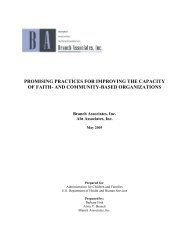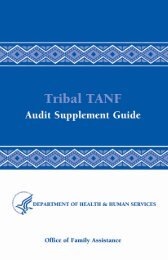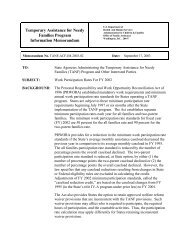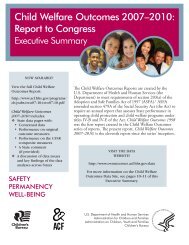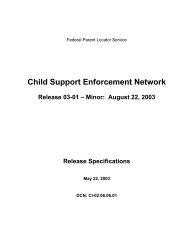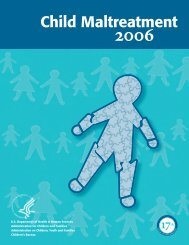Final Report of the Subcommittee on Domestic Trafficking
Final Report of the Subcommittee on Domestic Trafficking
Final Report of the Subcommittee on Domestic Trafficking
You also want an ePaper? Increase the reach of your titles
YUMPU automatically turns print PDFs into web optimized ePapers that Google loves.
The Federally funded system <str<strong>on</strong>g>of</str<strong>on</strong>g> care for unaccompanied refugee children has generallybeen able to adapt to <str<strong>on</strong>g>the</str<strong>on</strong>g> needs <str<strong>on</strong>g>of</str<strong>on</strong>g> trafficked children. Research and <strong>on</strong> going training isneeded since this is a new populati<strong>on</strong>; much remains to be learned. However, outcomesare generally good. It is easier to provide stellar services to <str<strong>on</strong>g>the</str<strong>on</strong>g> 47 unaccompaniedtrafficked children who have been identified during <str<strong>on</strong>g>the</str<strong>on</strong>g> last four years than to serve <str<strong>on</strong>g>the</str<strong>on</strong>g>possible thousands who may be arriving every year if we are to accept State Departmentestimates.The problem for internati<strong>on</strong>al child victims is <str<strong>on</strong>g>the</str<strong>on</strong>g> reluctance <str<strong>on</strong>g>of</str<strong>on</strong>g> law enforcement torequest services for possible victims and for HHS reluctance to <str<strong>on</strong>g>of</str<strong>on</strong>g>fer services absent sucha request. As children, <str<strong>on</strong>g>the</str<strong>on</strong>g>y are not always able to explain <str<strong>on</strong>g>the</str<strong>on</strong>g>ir situati<strong>on</strong> or support <str<strong>on</strong>g>the</str<strong>on</strong>g>ircase in a way that is understandable or c<strong>on</strong>vincing to a federal law enforcement <str<strong>on</strong>g>of</str<strong>on</strong>g>ficial.Federal <str<strong>on</strong>g>of</str<strong>on</strong>g>ficials are sometimes unwilling to request benefits in situati<strong>on</strong>s in which <str<strong>on</strong>g>the</str<strong>on</strong>g>ydo not have enough evidence; thus, no case manager or service provider is funded towork with <str<strong>on</strong>g>the</str<strong>on</strong>g> child. Therefore, children rescued from possible trafficking situati<strong>on</strong>s suchas bro<str<strong>on</strong>g>the</str<strong>on</strong>g>ls or bars where prostituti<strong>on</strong> is known to take place are not being determinedeligible for services as trafficking victims, even though <str<strong>on</strong>g>the</str<strong>on</strong>g> law specifically exemptschildren from cooperati<strong>on</strong> with law enforcement. They are given a “notice to appear” infr<strong>on</strong>t <str<strong>on</strong>g>of</str<strong>on</strong>g> an immigrati<strong>on</strong> judge for probable removal from <str<strong>on</strong>g>the</str<strong>on</strong>g> country. In some o<str<strong>on</strong>g>the</str<strong>on</strong>g>rcases, children are denied benefits, live an unstable life in <str<strong>on</strong>g>the</str<strong>on</strong>g> care <str<strong>on</strong>g>of</str<strong>on</strong>g> “Good Samaritans”but eventually are given a t-visa. But without <str<strong>on</strong>g>the</str<strong>on</strong>g> funded case management serviceswhich come with determinati<strong>on</strong> <str<strong>on</strong>g>of</str<strong>on</strong>g> eligibility, it is chancy whe<str<strong>on</strong>g>the</str<strong>on</strong>g>r or not <str<strong>on</strong>g>the</str<strong>on</strong>g> “GoodSamaritans” who are assisting <str<strong>on</strong>g>the</str<strong>on</strong>g>m can provide <str<strong>on</strong>g>the</str<strong>on</strong>g> help <str<strong>on</strong>g>the</str<strong>on</strong>g>y need before T-visa isissued.In <strong>on</strong>e case, a child was held by <str<strong>on</strong>g>the</str<strong>on</strong>g> federal government system for undocumentedchildren. There was some evidence <str<strong>on</strong>g>of</str<strong>on</strong>g> trafficking but <str<strong>on</strong>g>the</str<strong>on</strong>g> word <str<strong>on</strong>g>of</str<strong>on</strong>g> <str<strong>on</strong>g>the</str<strong>on</strong>g> child was difficultto corroborate; she was not picked up while actually engaged in a commercial sex act andfederal law enforcement <str<strong>on</strong>g>of</str<strong>on</strong>g>ficials felt unable to request trafficking benefits. Absent such arequest, HHS did not feel able to <str<strong>on</strong>g>of</str<strong>on</strong>g>fer a letter <str<strong>on</strong>g>of</str<strong>on</strong>g> eligibility for services despite herattorney’s request. The child was released to her mo<str<strong>on</strong>g>the</str<strong>on</strong>g>r who is seriously ill but <str<strong>on</strong>g>the</str<strong>on</strong>g>family was unable to access medical care, food stamps or o<str<strong>on</strong>g>the</str<strong>on</strong>g>r survival services. Thechild’s attorney believed that trafficking relief was possible and persisted with a T-visaapplicati<strong>on</strong>. Eventually, <str<strong>on</strong>g>the</str<strong>on</strong>g> child was granted a T-visa and can now receive serviceswhile in <str<strong>on</strong>g>the</str<strong>on</strong>g> care <str<strong>on</strong>g>of</str<strong>on</strong>g> a different relative. However, she did not receive services until 7m<strong>on</strong>ths after her case was first known by <str<strong>on</strong>g>the</str<strong>on</strong>g> federal government.In ano<str<strong>on</strong>g>the</str<strong>on</strong>g>r fairly recent situati<strong>on</strong>, four children were am<strong>on</strong>g possible trafficking victimspicked up in a raid <strong>on</strong> a bar where prostituti<strong>on</strong> was known to be taking place. A childremoved from <str<strong>on</strong>g>the</str<strong>on</strong>g> same situati<strong>on</strong> a few m<strong>on</strong>ths ago had been given benefits and is now incare. The children said <str<strong>on</strong>g>the</str<strong>on</strong>g>y were “just having a snack” <str<strong>on</strong>g>the</str<strong>on</strong>g>re and refused to disclose t<str<strong>on</strong>g>of</str<strong>on</strong>g>ederal law enforcement <str<strong>on</strong>g>of</str<strong>on</strong>g>ficials whe<str<strong>on</strong>g>the</str<strong>on</strong>g>r <str<strong>on</strong>g>the</str<strong>on</strong>g>y were engaged in commercial sex. One girlhas said “<str<strong>on</strong>g>the</str<strong>on</strong>g>y know where my family lives.” While circumstances point to childrencoerced to engage in commercial sex, <str<strong>on</strong>g>the</str<strong>on</strong>g> federal <str<strong>on</strong>g>of</str<strong>on</strong>g>ficials active in <str<strong>on</strong>g>the</str<strong>on</strong>g> investigati<strong>on</strong> feltunable to request benefits from HHS for those children. The children have been enteredinto removal proceedings and may be returned to <str<strong>on</strong>g>the</str<strong>on</strong>g>ir country <str<strong>on</strong>g>of</str<strong>on</strong>g> origin.65






